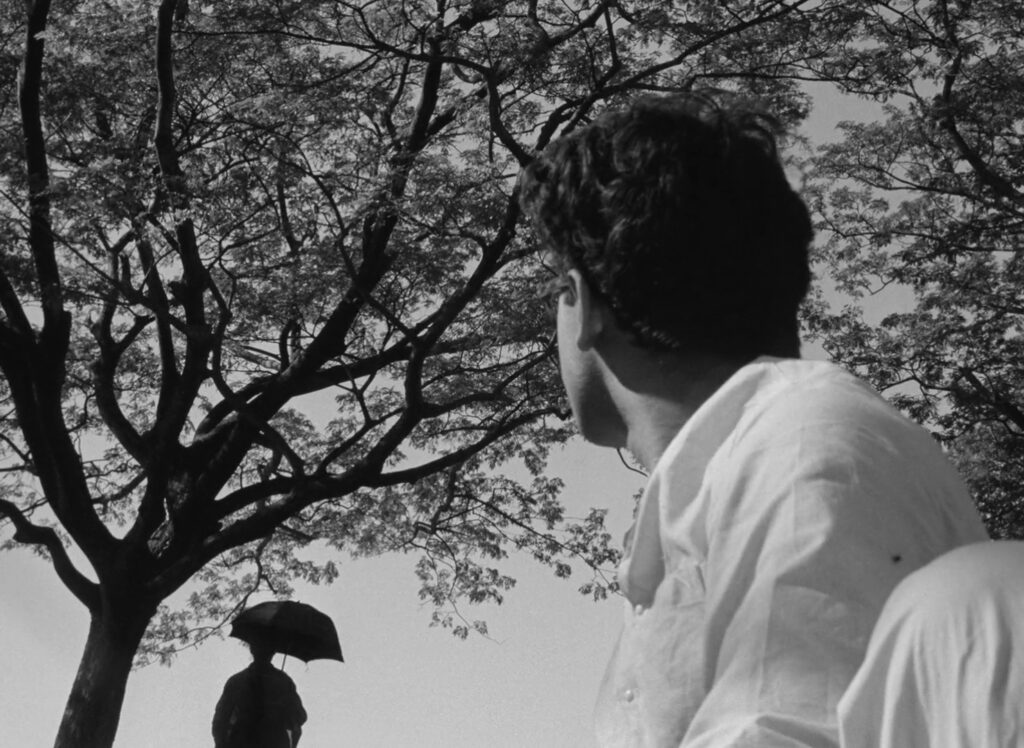
The Cloud-Capped Star
1960, directed by Ritwik Ghatak
At the beginning of The Cloud-Capped Star, Neeta emerges from under a most extraordinary tree. Terminating a row of similar trees along a lake shore, its impressive canopy spreads a huge dome of leaves around a stout trunk. The location will appear six more times, but until the last act it remains Neeta’s privilege among all the characters to emerge from this leafy firmament. In the film’s language it’s her tree, although her unnamed double, whom Shankar mistakes for Neeta, walks down the same path. Shankar, Sanat, and Geeta will also sit or walk in the vicinity of that tree, but they’re not framed like she is under the embracing foliage. The insinuation is clear: Neeta is like the tree, sheltering her family through hard times.
As Neeta’s mother tells us, the last ten years have been rough for the family. They’re living in a refugee settlement on the outskirts of Kolkata, driven there in the mass migration that followed the Partition of India as Hindus fled the newly-created East Pakistan, and Muslims likewise rushed in to what would (after this film) become Bangladesh. The family is from the educated Hindu bhadralok class, and the plot charts their respective efforts to rise back out of poverty. Each of their successes will happen because of Neeta’s sacrifice. Shankar’s musical talent, Geeta’s marriage to Sanat, and Montu’s healthy body and steady job were all once within her grasp, but she gives up all of these for her family.
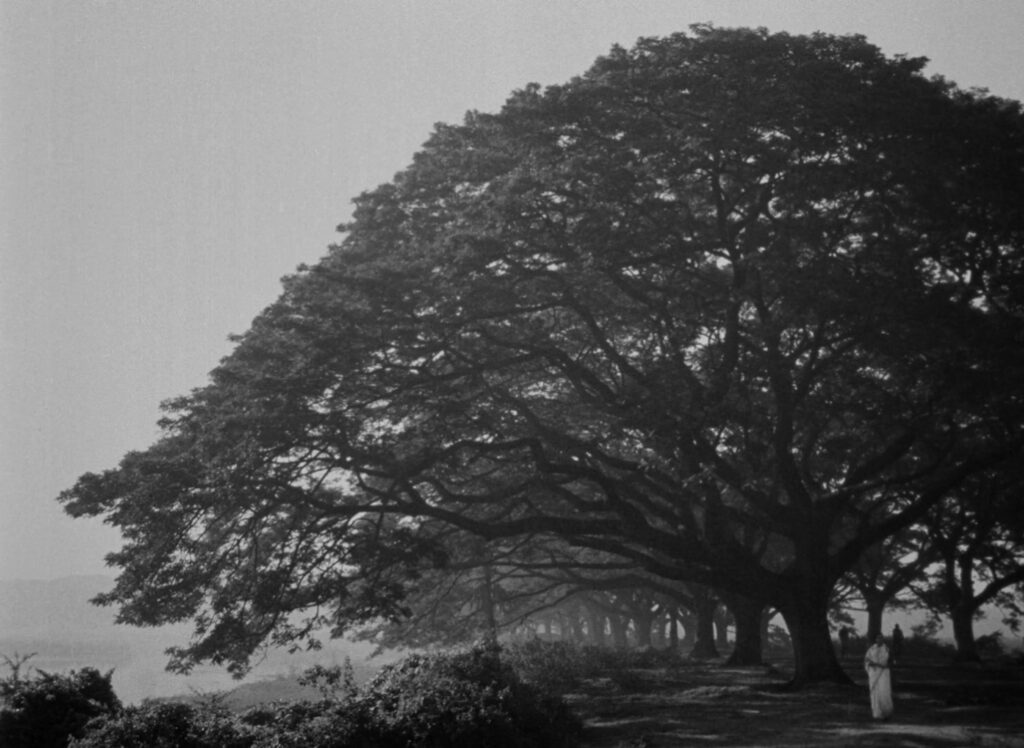
The image of the sheltering tree must be meant for Neeta, because its arching form is systematically echoed across the film. On three occasions Neeta carries an umbrella through central Kolkata, the only one to be seen on the crowded streets. Three times the lashing sound of a whip expresses her agony, each time paired with an arc in the shape of the tree: first at the round archway of Sanat’s hallway; second as her body folds into an arched silhouette; and third when she opens her umbrella under the big tree, doubling the dome motif in one shot. Her father also carries an umbrella around, but only to use as a cane, supporting himself instead of giving shelter. Only near the end when Neeta falls sick, and her elder brother Shankar returns wealthy from Mumbai, does another character follow her footsteps under that tree. Shankar arrives via his sister’s shaded path, singing a joyful song. He is now able to shelter the family as Neeta had done, and henceforth he will sometimes hold an open umbrella.
Like Neeta, Sanat is first seen under a tree, but it’s a barren leafless tree, and he won’t be the sheltering force that she is; but when he agrees to provide for Montu’s blood transfusion, he and Neeta meet under the round vault of the hospital corridor. For once he’ll be the provider he should have been, and he’s also framed by an arch when he comes home to find himself a father. Shankar is introduced in front of a steam train, a sign of the progress he’ll bring to the family with his eventual success. Geeta is introduced at a mirror, representing vanity but also reproduction, as she’ll add a new generation to the family. The younger brother Montu is introduced at a punching bag, and his life will be a physical struggle. He’ll play sports, work as a laborer, and suffer bodily injury. All of these characters represent basic social elements of a developing nation. The mother and father are not introduced with any visual signature, but he’s worrying and she’s complaining, and their useless speech will always stand in contrast to Neeta’s actions.
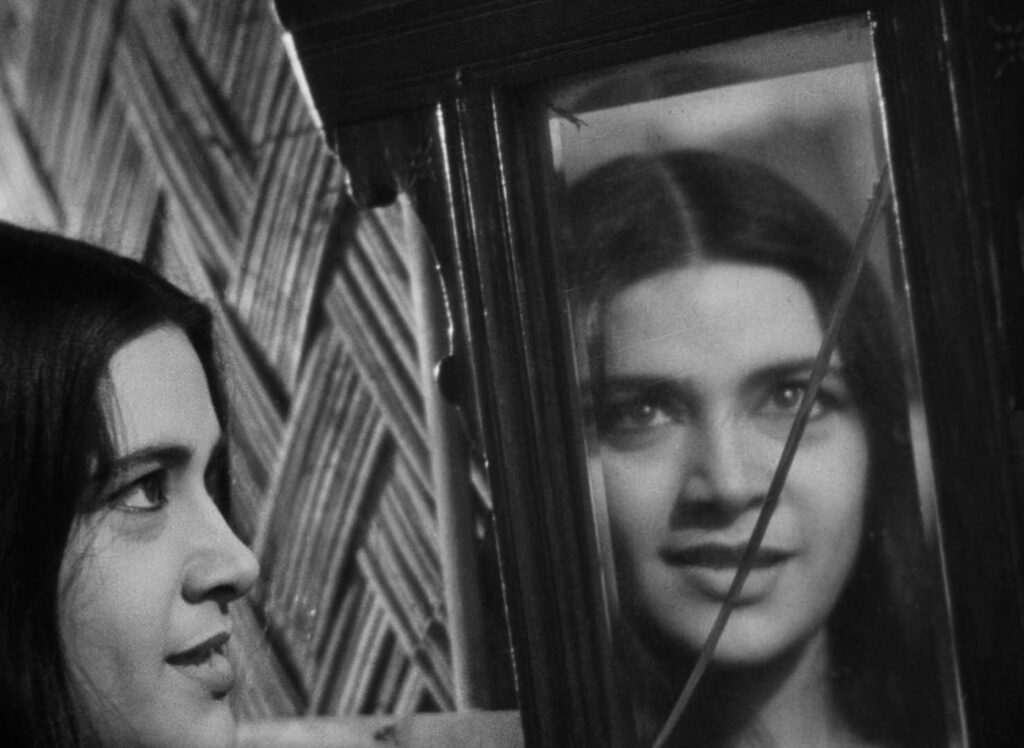
Toward the end, when Neeta has tuberculosis, her father calls her a success because she’s put everyone else “on their feet”. Accordingly, the film pays repeated attention to the characters’ footwear. Neeta breaks her sandal in the opening, but she’ll put off repairing it to help her family and to buy cleats for Montu. Shankar brushes off his worn shoes, and the two brothers quarrel over a pair of slippers. Neeta catches Sanat in elegant new shoes, bought with a salary that he should have shared with her. In her last conversation Neeta hears that Geeta’s son has begun walking.
Not only has Geeta’s baby learned to walk, but he’s also excited to climb the stairs, as Shankar tells Neeta twice right before her last words. The act of climbing stairs, and the home’s extension to two floors, is a metaphor for the family’s rising fortunes, which only Neeta does not share. Before their situation turns around they suffer a string of misfortunes, beginning with the father’s fractured leg. He falls across the railroad tracks, symbolically obstructing the progress that the train had represented before. Right after the father’s accident, Neeta descends a dark staircase in a Kolkata building, and she’s also headed down a staircase when the lashing whip first gives voice to her suffering. Unlike her family, her trajectory will be downward.
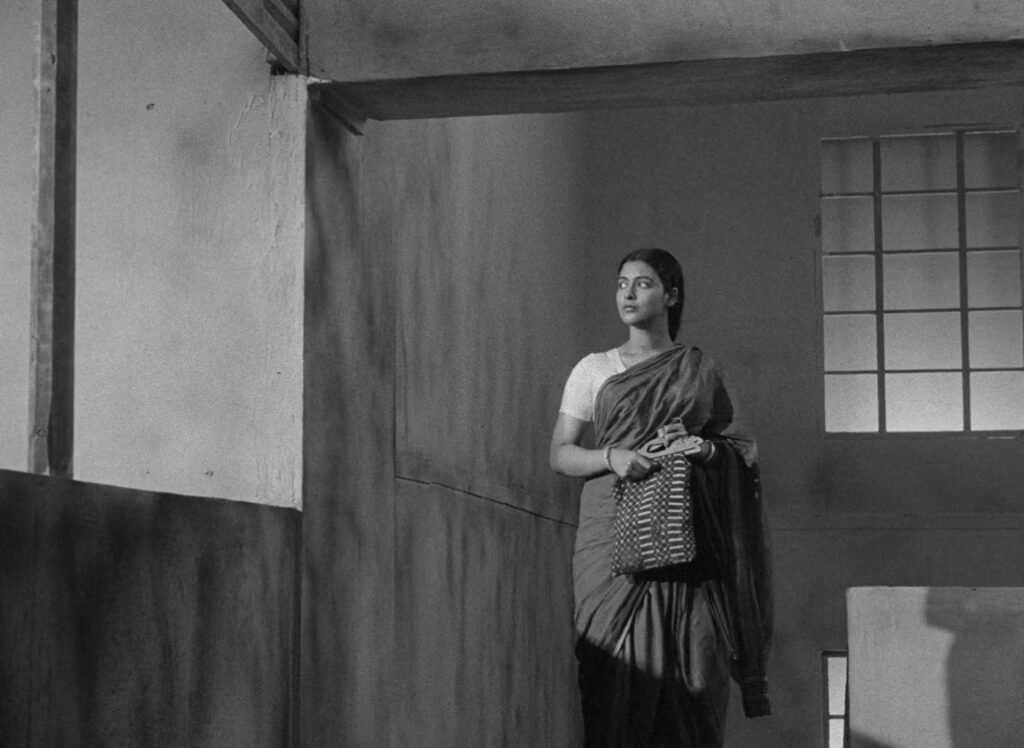
All these signs – the trees, umbrellas, arches, trains, shoes, stairways, etc. – demonstrate a rich and varied cinematic language that cannot easily be reduced to a single motif or a dominant pattern. The incidental details speak to us, but each in its own way. The film makes liberal use of doubling, but almost as much of tripling as well. The father, for example, quotes British poets three times: Yeats, Keats, and Wordsworth. If there’s any common denominator, it’s that nearly all the metaphors and repetitions point one way or another at Neeta. She’s very much the center of the movie.
When the father cites Wordsworth, he misquotes the poem Yarrow Unvisited, flipping the sequence of its two phrases: “Swan and shadow, float double!” The way he puts it calls attention to the duality of good and bad fortune in the family. Neeta will be the shadow, shouldering the family’s misfortune through her sacrifices.
Three times also, toward the end, we hear a song expressing a mother’s lament as her daughter leaves home to be married. It plays when Neeta exiles herself to the outer room; again when she leaves home; and finally at the very end when she’s dead. The second time, as she walks into the rain pulling a hood over her head, she faces the adverse elements with an unexpected, even unnatural, joy on her face. The insinuation is that she’s getting married, and that her groom is Death. The same idea comes across in the pairing of two scenes where Shankar giddily pries a purported love letter from his sister’s hands. The first time it really is a love letter; the second time it’s a bloody handkerchief, the token of her engagement to a more faithful lover.
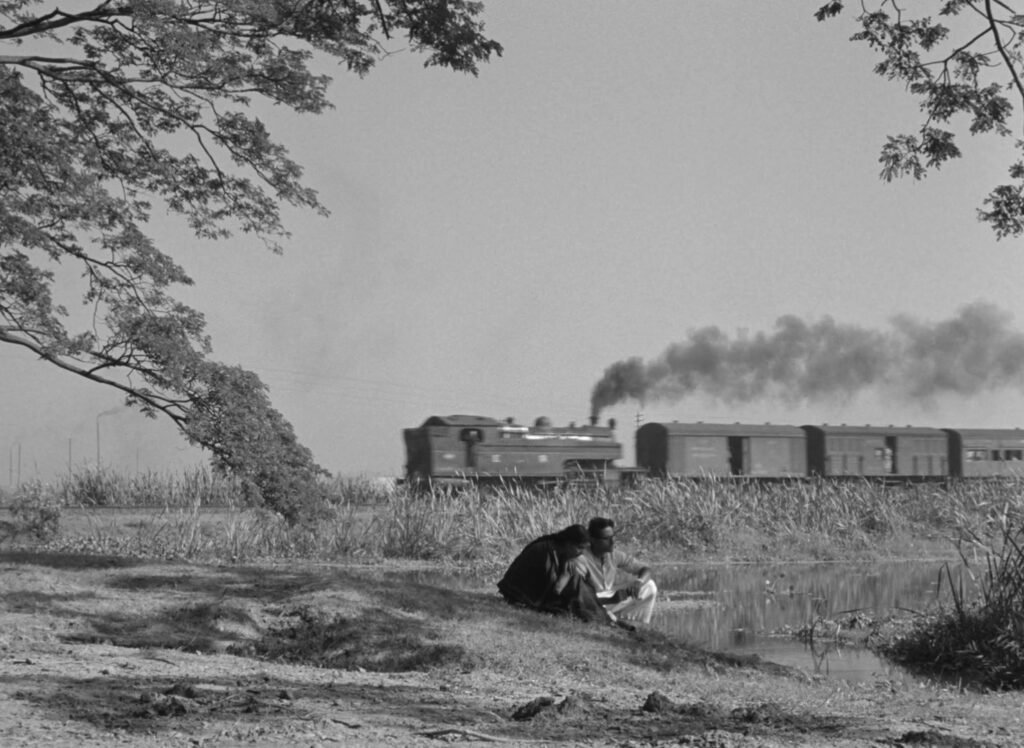
The film’s poetic title comes from Sanat’s love letter, and it points to Neeta, the “cloud-capped star” whose radiance is veiled by mundane circumstance. The film is so enamored of her that one would think it must be a tribute to some real woman in the life of director Ritwik Ghatak. Ghatak would likely identify with fellow artist Shankar, Neeta’s closest sibling, who achieves fame but owes everything to her. The final shot is of Shankar thinking of his sister, as if to mirror the director’s own thoughts. In fact the film is adapted from a novel, but the choice to adapt it, and the emotional force of its re-telling, show all the sincerity of real-life inspiration.
Nevertheless, it’s not sufficient to say that The Cloud-Capped Star pays homage to Neeta or to some real woman who may have inspired her. At the end, Shankar sees Neeta’s double a second time, now walking through the refugee settlement with a broken sandal just like Neeta before. The implication is that Neeta is not unique – that there are in fact thousands of Neetas in India, sheltering the people around them with a generous sacrificing spirit. The same idea is implicit in the opening titles, where a point of light in the rippled surface of flowing water forms a large star, but it’s surrounded by countless smaller stars.
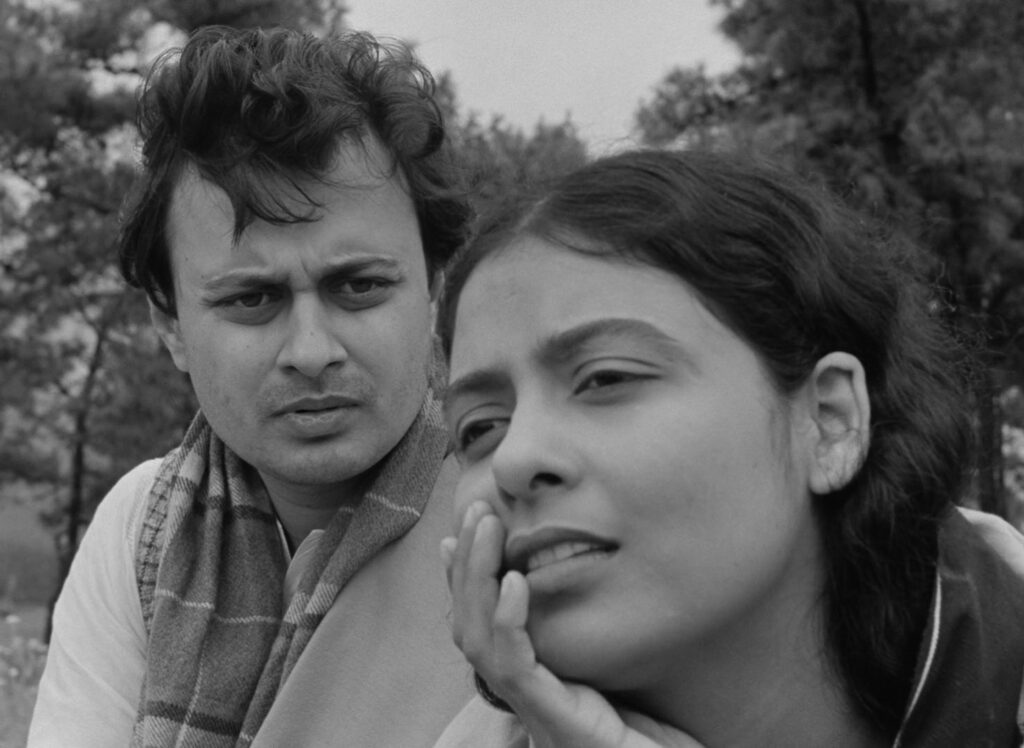
In the broader context of newly independent India, Neeta is a rebuke to the cynicism of partition. Upon granting independence, the colonial government had split India down sectarian lines with the outward premise of averting civil war. The decision had disastrous consequences, causing mass migrations, unexpected violence, and a legacy of bitter enmity between Pakistan and India. The Cloud-Capped Star is not so naive as to assert a uniform virtue in Indian society, but the existence of Neeta and the untold number of her likenesses expresses a faith that there’s enough goodness in India to triumph over forces of disorder.
CONNECTIONS:
Exit Smiling – Tribute to a particular type of person who typically goes through life unappreciated
Born Yesterday – Recurring motif of domes, with a connotation of shelter
Tokyo Story – Matrix of characterizations in a large family, with parents defined by their pattern of dialogue
The Big City – Rising and descending motion on stairs as a metaphor for a Kolkata family’s economic mobility
LIST OF DOUBLINGS & TRIPLINGS:
Father reminded to contribute to the refugee camp
Love letter / handkerchief
Father’s fracture / Montu’s accident
Sanat visits the house when Neeta needs to tutor a pupil
Neeta drinks a glass of water at Sanat’s old / new apartments
Geeta is behind the curtain when Neeta visits Sanat’s new place
Shankar sees Neeta’s acquaintance by the lake / in the settlement
Neeta tells Sanat / Shankar to put her in a glass case like a wax doll
Neeta brings unwelcome news of Montu home to her parents
Mother’s face shot from below surrounded by steam
Major musical interludes (2 or 3x)
Passing train (3x)
Geeta / her neighbor / Neeta pull hoods over their heads
Neeta takes an umbrella through Kolkata (3x)
Farewell song when Neeta moves to the outer room / leaves home / end of film
Father quotes British poets (3x)
Lashing sound of whip (3x)
Neeta paired with Ganesh or elephants (3x)